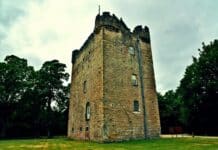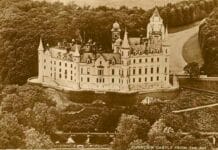Arden Street in Marchmont, Edinburgh, has a picturesque quality that hides eerie secrets, as WAYNE GILBERT reveals in the newly-released Tales from the Crypts of Auld Reekie
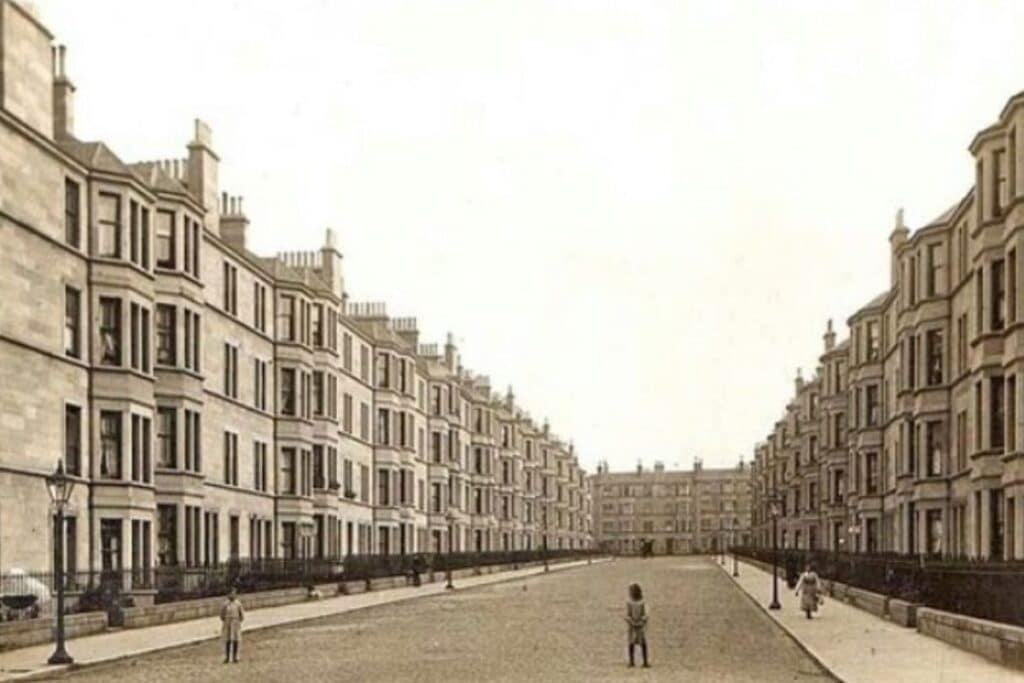
The scenic surroundings of Marchmont and Edinburgh’s Meadows form the setting for this story. A quiet, leafy property in the famous university area would play host to paranormal activity. Wayne Gilbert, the face behind Eerie Edinburgh, relays a story from his contribution to the new book Tales from the Crypts of Auld Reekie by John Tantalon.

When pondering the spectral tales of Edinburgh, one’s imagination instinctively drifts toward the historic narratives woven into the fabric of the ‘Old Town’. Extending from the imposing silhouette of Edinburgh Castle to the regal splendour of Holyrood Palace, this iconic thoroughfare steeped in love, life, and death for centuries, has become synonymous with ghostly encounters. Its towering tenements and intricate, shadow-laden closes, where light wrestles to pierce the pervasive gloom, conjure a vivid image of the eerie ambiance that defines this celebrated district.
It’s no wonder that thoughts naturally linger on the incorporeal lore echoing through the aged stones of the Old Town. Tales of satanic wizards, mysterious castles, and haunted underground streets have rightfully seized the zeitgeist and media attention. The ‘Mackenzie Poltergeist,’ as it’s colloquially known, has ascended to global fame as one of the most renowned modern ghost stories. Greyfriars Kirkyard, where the phantom is said to reside, attracts tens of thousands of tourists annually, drawn to experience the atmospheric allure and, perhaps, encounter the ghostly presence themselves. Yet, beyond these familiar precincts, an uncharted realm beckons, and Marchmont emerges as a contemporary canvas for Edinburgh’s ghostly tapestry.
Situated approximately a mile to the south of the famous Old Town, separated by the green expanse of The Meadows and Bruntsfield Links, Marchmont unveils itself as a predominantly residential enclave in the heart of Edinburgh, Scotland. Bounded by the genteel neighbourhoods of Bruntsfield to the west, Greenhill and Morningside to the south-southwest, The Grange to the south-southeast, and the enchanting district of Sciennes to the east, Marchmont stands as a testament to the city’s architectural heritage.
Distinguished by its impressive four- and five-storey tenement blocks, adorned in the distinct Scots Baronial style, Marchmont bears the hallmark of a bygone era. Most of its architectural composition took shape in the 1870s and 1880s, with the structure retaining its original charm through the ages. Today, Marchmont remains a popular location, attracting a diverse community that includes older residents, budding professionals, and inquisitive students.
In the mid-19th century, Sir George Warrender, owner of the nearby Bruntsfield House and the surrounding estate known as Warrender Park, envisioned Marchmont as a meticulously designed middle-class suburb. As Edinburgh experienced rapid population growth, the demand for housing surged. Architect David Bryce initially outlined a feuing plan in 1869, proposing mainly terraced villas with some large, detached villas along Marchmont Road.
In Marchmont’s residential fabric, a distinctive street stands out with a haunting intrigue—Arden Street: a wide, cobbled thoroughfare adorned with historic tenements, reflecting a mix of architectural styles that echo its rich heritage. Notably recognised as the residence of author Ian Rankin’s fictional detective Inspector John Rebus in contemporary literature, it’s also a hot spot for otherworldly activity.
Dutch and Flemish Renaissance paintings may not seem like a suitable subject for a chapter focused on eerie events in Arden Street, but it features heavily in our first story from the 1990s.
This unusual encounter was relayed to me by a former resident of the street whom we’ll call John, who lived in a large main door flat in Arden Street from the late 1980s to the early 2000s. A main door flat is a residential property, typically an apartment or flat, located on the ground floor of a building with its own private entrance directly from the street, distinguishing it from flats accessed through a communal entrance.
John’s parents purchased the property in the early 1980s when he was young, and he moved in when they relocated to the Highlands, going on to study art at Edinburgh University.
The property layout included a large main bedroom with a bay window on the right of the main door, where John slept, and a spare bedroom on the left, with a smaller box room adjacent to John’s room. The bathroom was situated at the end of the long, often gloomy, hallway that was illuminated by a small window above the main door, and the kitchen, serving as both the kitchen and living room, was the third room on the right. This room featured a door leading to the back garden and a skylight that brought natural light into the box room. As with a typical Edinburgh period home, the rooms were large, light, and with high ceilings.
Despite its familial ties, the home never offered John complete comfort, perpetually draped in an unsettling, dark ‘presence’ that he jokingly dubbed, “the devil walking up and down the hallway,” in conversations with friends. While John’s attempts at macabre humour initially served as a distraction, momentarily veiling his concerns in laughter, he couldn’t shake the persistent feeling of not being alone in the property.
Spooky footsteps heard in Arden Street
Even in sleep, no solace was found. A normally sound sleeper, John would occasionally be roused in the dead of night by the perceived sound of footsteps. Convincing himself that the measured pacing he sensed had suddenly halted the moment he awoke, he’d cautiously investigate, only to confront an empty and silent hallway.
After living in the property solo for a while during his studies, John decided to bring in a flatmate to share the expenses of maintaining a three-bedroom residence.
During his time in number 6, John befriended some of the neighbours and the more comfortable with him they became, the more they shared. Soon he became aware of stories of another house on Arden Street that also had its own spooky happenings.
In the 1960s, a student in one of the properties reported an unusual, auditory haunting. A committed student, while engrossed in his studies and no matter the time of day, he’d often experience the silence of his flat being broken by the faint sound of beautiful piano music. The compositions he could hear weren’t contemporary; this was music, he guessed, from the previous century, as if he was overhearing a private concert from a previous era.
On first hearing the ethereal eerie music, the student would search for the source of the noise, convinced it was coming from within the property. No matter how well he searched, he could never get closer to or further from the sound, but he was convinced that what he could hear was coming from his flat.
After a few weeks of his private ghostly concert, his curiosity to find the source of the playing waned and he grew to accept and appreciate the sounds that filled his home.
Although a few years before John’s time, the stories of this haunting further fueled John’s imagination and sense of unease when he was home alone and darkness fell.
It quickly became evident that the unusual experiences and unsettling feelings weren’t mere products of John’s imagination. Furthermore, these phenomena weren’t exclusive to him; the dark atmosphere left a lasting impact on visitors as well. Many expressed feeling uncomfortable within the property, describing an unshakable sense of being watched, particularly when navigating their way to the bathroom.
One flatmate, whom we’ll call James and who moved into the box room in the summer of 1998, also sensed something unusual about the property. He felt particularly uneasy in the hallway, having the distinct impression that there was an energy focused there. Similar to John, James would swear he heard slow footsteps pacing the hallway at night but there was no earthly sign of who, or what, made them. Sometimes, he would also find objects – just small insignificant objects, such as a book he’d been reading – moved around the box room, or into another room without explanation.
On one occasion, after showering and popping out to the local shop, he returned to find a towel – the towel he’d just dried himself down with and left on the radiator in the bathroom – was wrapped around an ornate wall light in his room. No one else was in the property at the time; he’d locked the main door on the way out, and the door to his room was shut when he left and remained shut when he returned.
As an art student, John had a particular interest in Dutch and Flemish Renaissance painting; particularly the works of Pieter Bruegel the Elder.
The art of Pieter Bruegel
Pieter Bruegel lived from 1525-1530 to 1569, and is widely regarded as the most significant of the Dutch and Flemish Renaissance painters. He was also the father of two sons, both of whom became famous painters in their own right: Pieter Brueghel the Younger and Jan Brueghel the Elder. Pieter Bruegel the Elder is perhaps best known for his 1565 painting, ‘The Hunters in the Snow’, but is also recognised for darker works, such as, ‘The Massacre of the Innocents,’ ‘The Seven Deadly Sins or the Seven Vices,’ and ‘The Triumph of Death.’ It was these darker works that held John’s interest more than most; the imagery and detail fascinated him from the moment he first saw them.
One of John’s favourite books was a collection of prints of the darker work of Bruegel, containing paintings, sketches, and etchings (although the name of the book now escapes him, he believes it was called something akin to ‘the Bruegel book of etchings’). It took pride of place in the Edinburgh Press next to his bed.
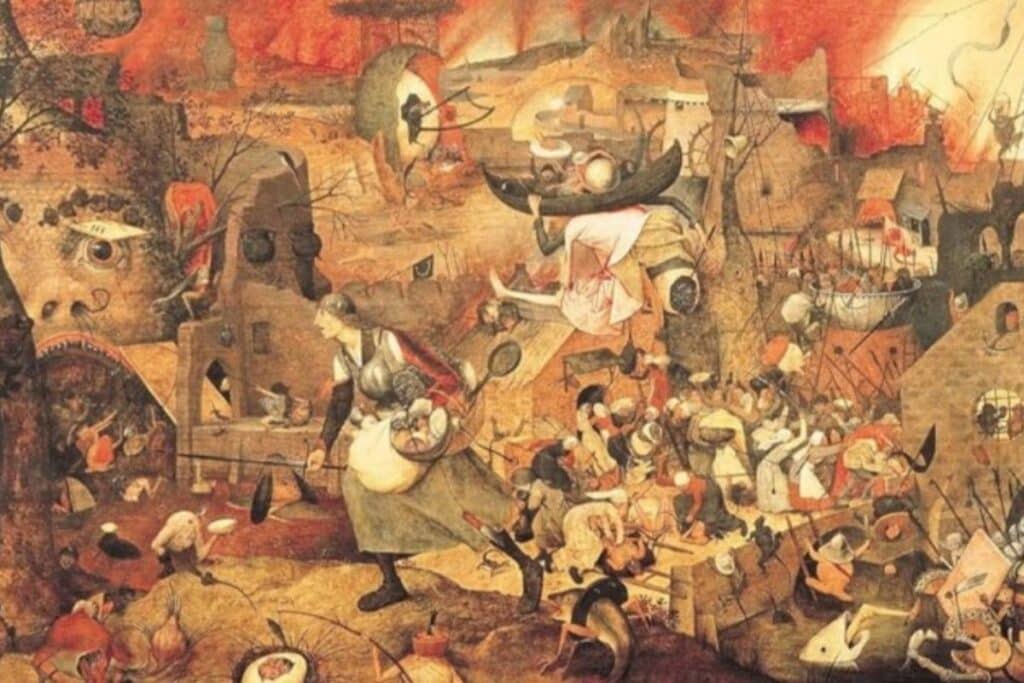
On a particularly dark winter morning, John roused from an unremarkable night’s sleep only to open his eyes to an unexpected sight. In Edinburgh, winter mornings carry a distinctive heaviness, especially in December when the sun hesitates to rise until after 8.00am. With his room shrouded in near pitch darkness due to the heavy curtains drawn, John reached over to switch on his night light, seeking a feeble glow to pierce the obscurity that enveloped the space. Now that his room was illuminated, he noticed the floor looked different: instead of carpet, it was covered with paper and, upon further examination, the paper was adorned with familiar images from his book on Bruegel. The first image he picked up was Dull Gret, or Mad Meg, depicting a scene where a woman (Meg) leads an army of women to pillage Hell.
Confused and a little horrified, he entertained the unsettling possibility that he might have been sleepwalking, even though he had no history of such episodes. Another unsettling thought raced through his mind — the potential intrusion of someone into his flat while he slept. Gingerly getting out of bed, John meticulously checked the doors and windows for any signs of a nocturnal intruder, but found none. Returning to his room, he picked up the images scattered on the floor. During this, he observed that none of them were torn; all seemed to have been perfectly removed from the book.
John is still looking for answers to this day.
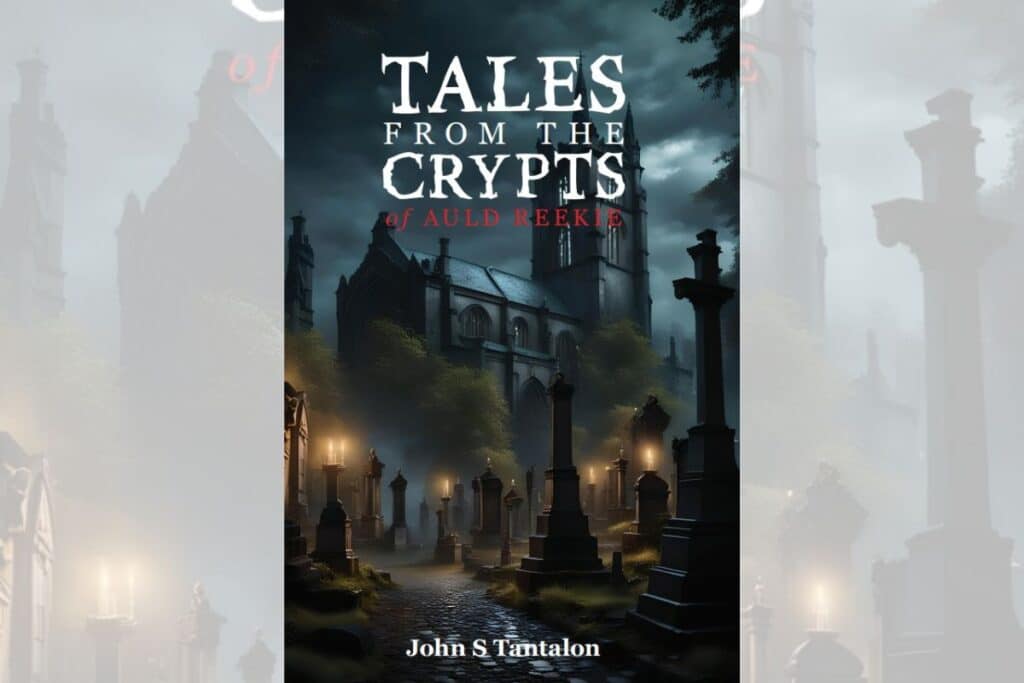
Tales from the Crypts of Auld Reekie by John S. Tantalon, from Saber Press, is available from North Edinburgh Nightmares website and Amazon.



